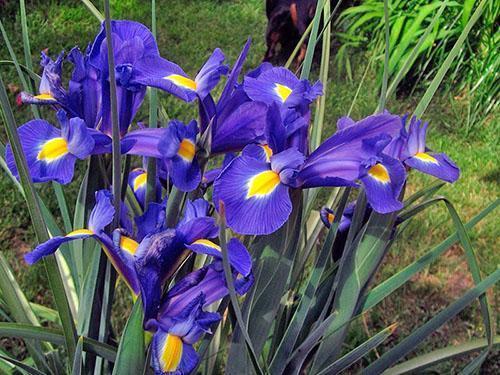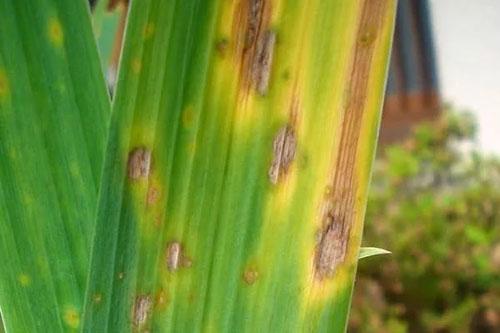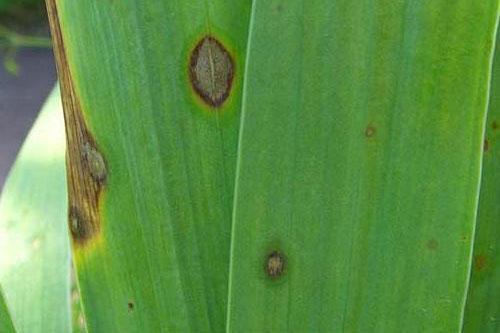Prevention and control of iris diseases
 Irises have become permanent inhabitants of our gardens for a long time. These handsome men are quite unpretentious, but nevertheless, from time to time, gardeners are upset with iris diseases and the fight against them takes a lot of time and effort.
Irises have become permanent inhabitants of our gardens for a long time. These handsome men are quite unpretentious, but nevertheless, from time to time, gardeners are upset with iris diseases and the fight against them takes a lot of time and effort.
The more refined the variety of the plant, the more it is susceptible to disease. The most common and common varieties are more immune. Below we will consider what diseases can be in irises, how to prevent them and what to do if the plant is still sick.
Iris diseases and their treatment
Compared to other perennial plants, irises are less susceptible to various diseases, but still not 100% protected from them.
Fungal, viral and bacterial diseases can rage on flower beds. An experienced gardener should be able to distinguish between them and treat them.
As a preventive measure, spraying with Bordeaux mixture works great before and after flowering..
For convenience, the diseases are listed below in alphabetical order.
Alternaria

Signs: The edges of the leaves begin to become covered with black bloom and die off.
What to do: unfortunately the plant will have to be removed. The virus spreads not only through contact, but also through soil. After the plant is harvested, it is necessary to cultivate the soil Bordeaux mixture.
Ascochitis or leaf spot
 Also a fungal disease.
Also a fungal disease.
Signs: Brown watery spots appear on leaf edges. The foliage begins to dry out.
What to do: preparations containing copper will help fight diseases. It should be noted that the disease remains both in the ground and in all parts of the plant. The method is suitable for any type of iris spotting.
Heterosporia
 The infection develops rapidly during rainy summers. Moisture and heat only contribute to the deterioration of the plant's condition.
The infection develops rapidly during rainy summers. Moisture and heat only contribute to the deterioration of the plant's condition.
Signs: starting from the bottom, the leaves begin to gradually die off. White-gray spots that gradually increase in size become a harbinger. The disease spreads to all leaves and eventually destroys the plant.
What to do: you need to constantly remove and dispose of the affected areas of the plant.
It is necessary to treat irises with products containing zinc and copper.
Mosaic
 Here, the ubiquitous aphid becomes a carrier.
Here, the ubiquitous aphid becomes a carrier.
Signs: small stripes and spots on the leaves.
What to do: No cure has yet been found to cure this infection.
Here, attention should be paid to prevention. You must tirelessly fight aphids and immediately remove infected plants.
Rust
 Fungal disease, the spores of which remain and develop in leaves and soil.
Fungal disease, the spores of which remain and develop in leaves and soil.
Signs: leaves begin to dry gradually, curl. They become brown.
What to do: sulfur solution every 2 weeks.
To prevent it, you need to keep the irises in the same place for 3-4 years. Good drainage is also required.
Wet rot or bacteriosis
 It manifests itself in early spring, refers to bacterial diseases.
It manifests itself in early spring, refers to bacterial diseases.
Signs: brown spots on leaf tips. Their subsequent drying. A rotten smell appears at the base.
What to do: Infected tissue should be cut off until healthy. Process with potassium permanganate.
Always remove affected foliage and plant debris in the fall.
Gray rot
 Fungal disease, activated by high humidity.
Fungal disease, activated by high humidity.
Signs: The stems and tips of the leaves are rotting and covered with a gray coating. The tubers of the plant are also affected.
What to do: do not flood the plants, even temporarily stop watering. Remove infected parts of irises, do not leave them in the area.
Dry rot or fusarium
 Signs: Infection starts from the rhizome and gradually clogs all the canals. The leaves wither quickly, the plant dies.
Signs: Infection starts from the rhizome and gradually clogs all the canals. The leaves wither quickly, the plant dies.
What to do: destroy or take out the dead plant. Treat neighboring plants with fungicides, and fill the place of growth of the deceased with copper chloride.
Do not spray during flowering!
The most important thing in the fight against disease is prevention and adherence to agricultural practices. Beautiful and healthy plants!